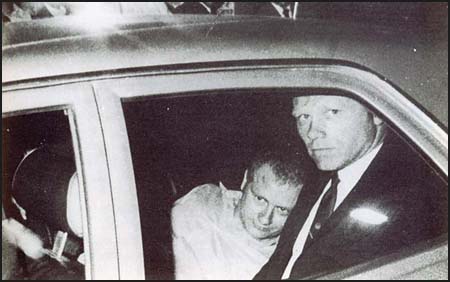Pax Nortona – A Blog by Joel Sax
From the Land of the Lost Blunderbuss
Home - Milestones - His Penis Stays Silent
His Penis Stays Silent
Posted on August 25, 2007 in Milestones Scoundrels Violence
 Arthur Bremer is scheduled to be released from the Maryland State Penitentiary soon. The younger generation may not remember the former janitor who shot [[George Wallace]] and turned him into the time’s political [[Ironside_(TV_series)|Ironsides]]. Even though he made an insanity defense, [[Arthur Bremer|Bremer]] hasn’t spent any time getting psychological care and he has turned down a psych evaluation that the Secret Service requested. This didn’t deter the Maryland parole board from letting him go in a few weeks.
Arthur Bremer is scheduled to be released from the Maryland State Penitentiary soon. The younger generation may not remember the former janitor who shot [[George Wallace]] and turned him into the time’s political [[Ironside_(TV_series)|Ironsides]]. Even though he made an insanity defense, [[Arthur Bremer|Bremer]] hasn’t spent any time getting psychological care and he has turned down a psych evaluation that the Secret Service requested. This didn’t deter the Maryland parole board from letting him go in a few weeks.
Assassins are a hair’s breadth from the rest of us, a distance that we find disturbing. Yet there are reams of material written about them and the crimes they committed. After serial killers, they are the archdemons of true crime, erasing with a single bullet or a bomb the political focus of cities, states, and nations.
Unlike other events of the type, I can’t tell you where I was when the word got out that Wallace was shot. I would have been in eighth grade and the news might have come from one of my working class white schoolmates. San Bernardino was a railroad town back then. A lot of families rode the [[Atchison, Topeka and Santa Fe]] west from Texas and the Deep South to the terminal. White boys wore white t-shirts and growled at the black students who they thought were taking over their turf and having an easy life.
For them, the attempt on George Wallace — the angry white voter’s candidate — signaled something like [[Helter_Skelter_(Manson_scenario)|Helter Skelter]], the bigot’s wet dream of a final showdown with the Negro. School leaders put an extra-tight cap on violence in those months. The shooting was not discussed as a current affair. The California primary happened, [[George McGovern]] won, Wallace got most of his votes out of Orange County, and then it was on to the convention.
It was surprising that we did not have an outbreak of violence as we had had the year before. A gang of white students and a gang of black students met in the corridors of the last line of classrooms. Ninth graders organized the affair, consciously thinking of the impression that they would leave on their younger schoolmates. The explosion was short. We eagerly listened to eyewitnesses who could tell us who hit who and what teachers arrived to end the fracas. The riot was a widely known secret before it happened. No one told the school administration what was up. For several days, there were lock-downs where lunches were moved about and students held in classrooms.
All the breath of those pubescent teenagers piled up between the desks. No talking was permitted, but news got around anyways, usually during gym period. Boys in reversible white and red t-shirts told stories. The most chilling was that a guy had brought a gun and put it in his locker to use on “the niggers”. Growing up, it was not the terror of gangstas that moved me but of the prides of Texas and Oklahoma who were leaning on the wire fences waiting for the signal to begin Helter Skelter.
Arthur Bremer was an anomaly, a white man who stalked [[Richard M Nixon]] and Wallace. I don’t think my peers knew what to make of him. He didn’t kill liberals. His diaries spoke of his attempted murder as a passage into manhood. My cohorts never spoke of him as a traitor as their father’s might have, but as a mystery, a man who wore dark glasses. Bremer shot their champion and for a moment, at least, they shut up, before turning their support to the new angry white man’s candidate, Nixon.

[tags]assassins, assassinations, Arthur Bremer, Bremer, parole, paroles, crime, mental illness[/tags]

